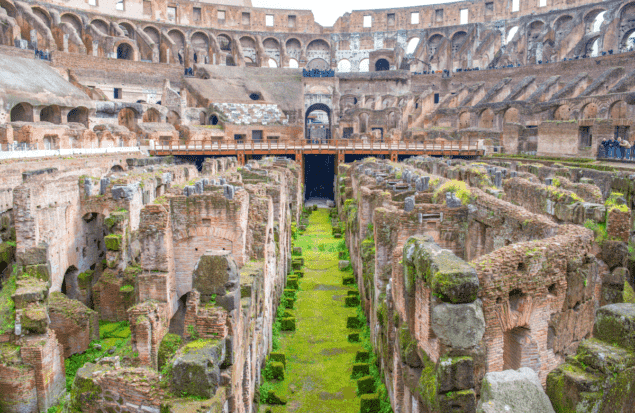Did the Romans build seismic invisibility cloaks?
Ancient Romans may have built structures that acted like invisibility cloaks long before physicists had any idea about metamaterials or transformation optics. That is the surprising claim from researchers in France, who found that the pattern of foundations in some Roman theatres and amphitheatres very closely resembles the features of electromagnetic cloaking devices. They say that these “archaeological metamaterials” could have indirectly provided protection against earthquakes, by bending seismic waves around the arenas.
Metamaterials are artificial structures comprising arrays of resonators that manipulate electromagnetic waves or sound in ways not normally found in nature. A mathematical framework called transformation optics has been developed to design novel devices made from metamaterials – including invisibility cloaks that divert microwaves round objects.
One potential application of metamaterials is the creation of structures that divert seismic waves around buildings in order to protect them from earthquakes. The idea is to surround a building with a lattice of holes or solid objects within the soil. When seismic waves within a certain range of wavelengths pass through the lattice, multiple reflections in the lattice interfere with one another destructively to create a band gap that results in a significant reduction in the shaking of the building.
Stéphane Brûlé and civil engineers at the company Ménard in Lyon, together with researchers at the Fresnel Institute in Marseille, demonstrated this idea in 2012, when they drilled a two-dimensional array of boreholes into top soil, each 5 m deep. By generating acoustic waves using a source close by, they found that much of the waves’ energy was reflected back towards the source by the first two rows of holes.
Uncanny resemblance
However, Brûlé reckons that the ancient Romans may have got there first – although unwittingly. He was on holiday looking at archaeological remains in the town of Autun in central France when he saw an aerial photograph showing the foundations of a Gallo-Roman theatre buried under a field just up the road. Although barely discernable, the markings in the field showed the outline of the first century AD building and he reckoned the semi-circular structure bore an uncanny resemblance to one half of an invisibility cloak.
This was confirmed by a photo from an archaeological study carried out a few years earlier that mapped the theatre’s foundations with much greater clarity. Superimposing that photo and one of a 20 cm-diameter invisibility cloak built by Brûlé and colleagues at the Fresnel Institute, he found that the theatre pillars and the elements of the cloak lined up almost exactly – each being arranged on a series of concentric (semi) circles that get closer to one another at smaller radii.
Brûlé then found that the same thing applied to the foundations of the Colesseum in Rome and other amphitheatres – which, unlike semi-circular theatres, are fully enclosed. In particular, he discovered that the ratio of the radii of neighbouring concentric circles (or ellipses, in the case of most amphitheatres) were almost identical. “I can’t show you the superposition with the amphitheatres yet,” he says, “but it is very impressive”.
Experience or luck?
As to how the Romans might have arrived at this design, Brûlé suggests that they may have gradually modified their amphitheatres thanks to the experience gained over the course of several centuries in highly seismic areas. But he is reluctant to offer details. Indeed, he says it might simply have been a matter of luck – that the foundations well suited to static loads also happened to resist earthquakes. “Rigorously,” he adds, “we cannot say more for the moment”.
Read more

How forests could limit earthquake damage to buildings
Sébastien Guenneau at the Fresnel Institute has carried out computer simulations to test the idea but says that the complexity of real soil and its influence on the passage of seismic waves means that experiments in the field are essential. He is hoping to build a model consisting of buried concrete piles arranged in characteristic concentric ellipses with an outer diameter of at least 20 m. This scale, he explains, would be suitable for the (short-wavelength) seismic waves that propagate in soft soils.
Another French group, led by Philippe Roux at the Earth Science Institute ISTerre in Grenoble, is also applying transformation optics to structures above ground. For instance, it has shown that forests can act as metamaterials, thanks to the fact that trees with a certain distribution of heights can divert some of the energy from seismic waves away from the Earth’s surface.
Metropolitan metamaterials
Researchers are also applying this thinking to cities of the future by studying how dense groups of tall buildings such as skyscrapers can act collectively as metamaterials. The idea, says Brûlé, is that those buildings modify passing seismic waves by vibrating and then acting as secondary sources that re-emit part of the initial seismic energy. In future, he reckons, smart cities could perhaps be arranged such that buildings divert seismic waves away from central areas containing essential services or schools, and that they could even tap some of waves’ energy to produce electricity.
For the moment, however, he simply wants people to be aware that when it comes to minimizing earthquake damage the design and location of buildings matters. Scientists and engineers, he says, should “take a closer look at ancient architectures and learn from these beautiful and amazingly resilient designs.”
The study is described in a review paper on the arXiv preprint server.
FROM PHYSICSWORLD.COM 26/4/2019

Δεν υπάρχουν σχόλια:
Δημοσίευση σχολίου